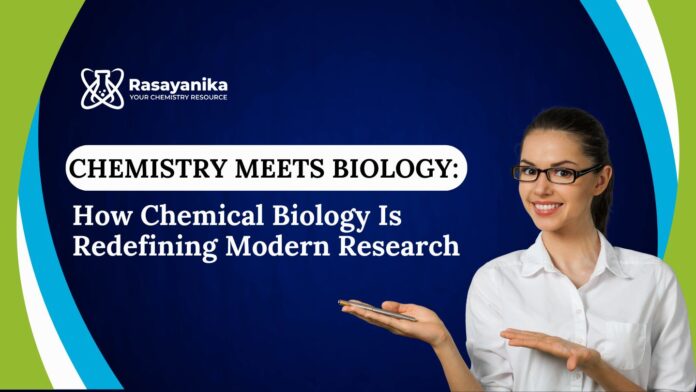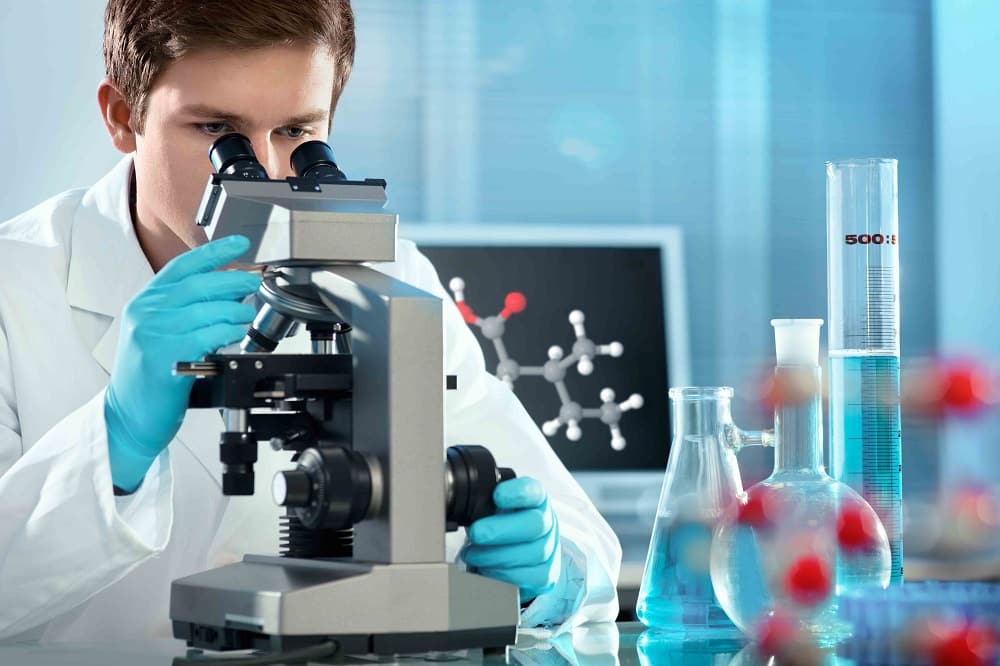Chemistry Meets Biology: How Chemical Biology Is Redefining Modern Research
Have you guys tried Gulab jamun with ice cream? I am sure that those with a “sweet tooth” who have tried and tasted definitely love it. Both desserts are giving an enhanced taste wherein a unique flavour is created, and our taste buds are the happiest to feast on this.
Just like how when two famous desserts are together, they provide a relishing effect, two of the ever-evolving subjects of science are unlocking bigger frontiers in science. This intersection of Chemistry and Biology is termed Chemical Biology.
This intersection of chemistry & biology is unlocking secrets of life that were once invisible to the human eye. From designing life-saving drugs to exploring how molecules communicate within living cells, chemical biology is revolutionizing modern research that has high future potential.
What Is Chemical Biology and Why Does It Matter?
Before diving into its groundbreaking applications, let us understand in detail what exactly chemical biology is.
Chemical biology is the branch of science that uses chemical techniques and molecules to manipulate biological systems. The main aim is to understand the life forms at their fundamental levels and precisely use the chemicals to manipulate them further for advanced uses.
Many of you must be wondering about this intersection and whether it’s the same as biochemistry. But let us help you clear the confusion here. Chemical Biology is one of the proactive branches of science where researchers are inventing new and advanced chemical tools to understand and crack novel biological questions. This approach primarily aims to help scientists understand the details of protein folding mechanisms. Even to understand the molecular processes of how any disease starts at the basic level. Also, the branch will aim to find solutions using chemical techniques.
Harvard University describes it as “the science of using chemical tools to study and control biological systems,” while the NIH calls it “a bridge connecting chemistry, biology, and medicine.” That bridge is what makes chemical biology so uniquely powerful.
Where Chemistry Meets Biology: The Perfect Partnership
The relationship between biology and chemistry has always existed, but chemical biology gives it purpose and direction. Biology provides the complexity of life, such as DNA, proteins, cells, and tissues, while chemistry offers precision, control, and creativity.
When these two come together, the observed results have been transformative:
- Chemical control of biology: Scientists can design molecules that switch biological functions on or off, allowing them to study cellular behavior in real time.
- Drug discovery revolution: Instead of relying solely on natural molecules, chemists can now build entirely new compounds that target specific disease proteins.
- Visualizing life at work: Chemical probes, such as fluorescent dyes and bioorthogonal tags, make invisible biological processes visible.
This partnership between chemistry and biology is like giving scientists a molecular remote control; they can explore how life works, one chemical interaction at a time.
Techniques Driving Chemical Biology
One of the most fascinating areas of chemical biology lies in its versatility. Scientists have curated an entire “toolbox” of methods that merge chemical synthesis with biological experimentation. We have listed a few of the most exciting ones in this article below;
- Bioorthogonal Chemistry
Bioorthogonal reactions are chemical reactions that can occur inside living organisms without interfering with natural biological processes. This allows researchers to label, track, or even modify molecules in living cells. These do not actually hamper the regular functioning of cells. This is one of the revolutionary tools that helps in various research studies ,such as molecular imaging and cell tracking.
- Targeted Protein Degradation
One of the most promising advances in chemistry, biology, and science is the development of PROTACs (Proteolysis-Targeting Chimeras). Instead of merely blocking a protein’s activity, these smart molecules tag it for destruction. This potentially allows scientists to remove the harmful proteins present inside the body and is one of the major advances helping therapeutic research areas.
- Chemical Probes and Imaging Agents
Fluorescent chemical probes act like molecular flashlights, illuminating how proteins, lipids, and nucleic acids behave in living cells. These probes help scientists monitor drug responses, disease progression, and even neural activity.
- Synthetic Biology Synergy
When chemical biology meets synthetic biology, the result we observe is one of the best molecular engineering techniques. Scientists can now engineer artificial pathways in microbes to produce valuable compounds. This ensures that one can obtain in-demand products such as eco-friendly biofuels as well as complex pharmaceuticals.
- AI-Driven Molecule Design
The rise of artificial intelligence has brought a new dimension to chemical biology. AI algorithms can now predict how new molecules will behave in biological environments, accelerating drug design and discovery.
Real-World Success Stories in Chemical Biology
The applications of chemical biology aren’t limited to the lab — they’re changing lives around the world.
- Turning waste into medicine: Researchers recently used E. coli bacteria to convert plastic waste into the painkiller paracetamol, using chemical reactions that operate within living cells. This stunning breakthrough demonstrates how chemical biology can help solve both health and environmental challenges.
- Targeted cancer therapy: By designing small molecules that specifically destroy cancer-driving proteins, chemical biologists have opened a new era in personalized medicine.
- Neuroscience insights: Using chemical tools to track neurotransmitters, scientists can now observe how brain cells communicate — providing clues to conditions like Alzheimer’s and Parkinson’s.
- COVID-19 drug discovery: During the pandemic, chemical biology techniques enabled rapid identification of molecules that could interfere with viral replication, demonstrating the field’s global relevance.
How Chemical Biology Is Redefining Modern Research
What makes chemical biology so revolutionary is its ability to blur the boundaries between scientific fields. Traditionally, biology explains what happens, while chemistry explains how it happens. Together, they reveal why it happens — and how to change it.
Chemical biology has redefined modern research by:
- Bridging disciplines: It connects molecular biology, organic chemistry, pharmacology, and biophysics under one umbrella.
- Empowering precision medicine: It enables the creation of drugs tailored to individual molecular signatures.
- Accelerating discovery: Through molecular engineering, we speed up testing and optimization of new compounds.
- Expanding sustainable solutions: By merging chemistry and biology, scientists are engineering organisms that create materials, fuels, or medicines sustainably.
As one researcher from MIT noted, “The next century belongs to interdisciplinary science, and chemical biology is its beating heart.”
Challenges Along the Way
Despite its success, chemical biology faces a few challenges that drive further innovation: A few of the challenges are listed below.
- Molecular complexity: Biological systems are incredibly intricate. This will make designing of the molecules highly difficult. To obtain functionally perfect, highly specific molecules will be a thorough task.
- Delivery issues: Getting chemical probes or drugs into specific tissues remains a technical hurdle.
- Cross-disciplinary training: Bridging chemistry and biology requires scientists fluent in both fields. One should have a skillset in both subjects to work efficiently.
- Ethical and safety considerations: Manipulating living systems at the molecular level demands strong oversight and bioethical awareness.
One can overcome these challenges if interdisciplinary research is encouraged more and people are allowed to have innovative as well as creative collaborations.
The future of chemical biology promises to lead the next wave of discovery. With tools like CRISPR, AI-designed molecules, and nanoscale imaging, we are now capable of not only studying life, but also of reshaping the fundamental units of life with utmost precision at the molecular level.
Imagine designing drugs that self-assemble inside cells, or molecules that can sense disease before symptoms appear. What was once assumed to be science fiction is now being displayed in front of our eyes. With further advances in science and technology, chemical biology will truly help create the future of medicine, sustainability, and human health.
As curiosity continues to drive innovation, this fusion of biology and chemistry stands as proof that the most remarkable discoveries happen when disciplines unite.













































